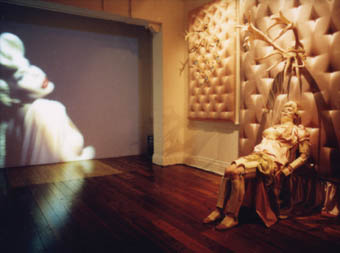Tied to an estranged self
Jacqueline Millner

Monika Tichacek, Lineage of the Divine, Cerebellum
photo Liz Ham
Monika Tichacek, Lineage of the Divine, Cerebellum
In her video installation, Lineage of the Divine, Monika Tichacek weaves a complex and visually sumptuous narrative. The protagonist, New York personality Amanda Lepore, is trussed in a salmon-pink, 1950s tailored suit, blonde hair in a net, lips overripe and gleaming, feet squeezed into precarious high heels. The figure paces a room with small, delicate steps, arms crossed, striking a pose in full awareness of being on display. This fetishistic assertion of archetypal femininity raises suspicions about the ‘true’ gender of the figure: is this really a woman or is ‘she’ just acting out? The figure appears to scan the gallery space, which also screams feminine cliché with its walls of studded pink satin, recalling a padded cell as much as the frou-frou bedhead that might grace a girl’s suburban bedroom. The feminine symbolism is interrupted by unmistakably phallic antlers that protrude from the wall, reinforcing the fetishistic yet sexually ambiguous ambience. The antlers, cast in resin in various sizes, evoke a dangerous male sexuality, but also look like children’s sporting trophies.
Close-ups and slow pans fragment and confuse the viewer’s perspective of the figure and the room, although it eventually becomes clear that there are 2 almost indistinguishable personae. The central figure is contemplating another, who lies sleeping, attired in identical clothes and make-up—this is the artist herself. A panning shot reveals that the 2 are conjoined by their hair—a blonde switch that snakes around the room, like an umbilical cord. The first figure slowly comes to touch the other, takes the other’s head in her lap before kneading her face and waking her. All the movements are slow and deliberate, choreographed actions intended for public view not for intimate exchange. Under her pink suit the artist wears flesh-coloured prosthetic casings on her limbs and torso that appear to be attached by strings and hooks to her skin. The first figure pulls these, scratching between flesh and plastic as if to manipulate, or liberate, the other. This scene is underscored by a video image on the facing wall that depicts the artist in prosthetics almost entirely still, breathing shallowly as though in an effort to control pain. She appears compelled to witness the scene opposite, over which she has no control.
Tichacek’s tableau recalls Frida Kahlo’s self-portraits, where the painter often expressed her sexually and culturally conflicted identity through the representation of physical pain, integrating the prosthetics she needed to contain her ravaged body into her compositions. In The Two Fridas, the artist represented herself as 2 women, separate but inseparable, sharing blood and holding hands, but riven by cultural contradictions (one wears indigenous Mexican garb, the other the high-collared lace of Spanish dress). Kahlo exquisitely aestheticised her pain and incapacity, her prosthetics and broken spine are as much a literal depiction of her experience as metaphors for her condition as a Mexican woman of a certain class. This aestheticisation, and extreme feminisation, of prosthetics, pain and incapacity, of dependence and strictured movement, also has a strong presence in Tichacek’s work, as does the metaphor of a divided self. Indeed, the symbolism in Lineage of the Divine crosses well into the bounds of overkill, though it is clear that this excess, this hysterical accumulation of charged signs, is very much the intention of the artist, as she forces us to confront the cultural phenomenon of femininity as well as the process of artistic creation. In seeking to articulate both art and sexual identity, the artist necessarily falls back on the language and gesture of cultural stereotypes. This sense of the need to speak with a borrowed tongue is echoed later in the video’s loose narrative, when the first figure lip syncs and shimmies a la Marilyn Monroe to Secret Love, Doris Day’s hit song that later became emblematic of closet lesbianism. The figure appears fated to perform this ritual of celebrity sexual tease; unable to speak her own language, she is forced to communicate through cliché.
However the overall effect of Tichacek’s installation is neither clichéd, nor a familiar exercise in parody and pastiche. Rather, what the artist has created is a seductively claustrophobic but moving evocation of the self-imposed strictures of identity, particularly but not exclusively, those of femininity and the artist. Like the central character in Bergman’s Persona, Tichacek’s protagonist discovers herself through and exploits her muse, is entirely beholden to and relies on her for her very survival, but rejects her, recovers the power of speech through her muse’s confessions but keeps her most intimate thoughts for others. She is one and the same person, but also entirely estranged from herself. Lineage of the Divine powerfully captures this complicity and estrangement between the authentic self and that reliant on cultural stereotype for realisation.
Lineage of the Divine, Monika Tichacek, part of group exhibition Cerebellum for Sydney Gay Games, curator Gary Carsley, The Performance Space, Sydney, Nov 2002. www.performancespace.com.au
RealTime issue #53 Feb-March 2003 pg. 28






